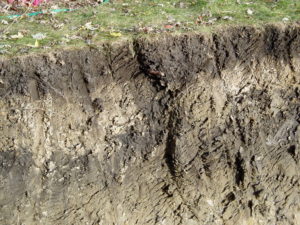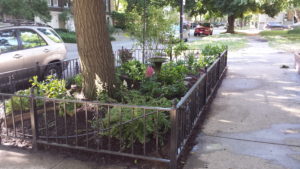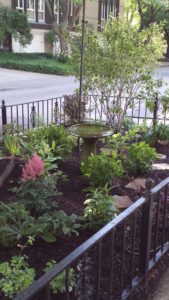Horticulturist Ken Williams tells us about a book that reveals the importance of sustainability.
Read More5 Ways to Be a Sustainable Gardener in 2019
/It’s time to begin thinking about the 2019 garden. If you are new to sustainable gardening, or if you want to introduce others to how to be more sustainable, here are the places to start:
Mulch grass clippings into your lawn. This is the most basic thing for everyone to do. If your landscape crew rakes and disposes of grass clippings, you are giving away the best source of nitrogen in your yard. Ask your crew foreman to use a mulching mower, and if your company does not have them, ask them to buy one. If they won’t do so, look elsewhere! Over time, using your own grass clippings will help you reduce the cost of lawn fertilization significantly.
Make compost and use it to fertilize your soil. This is another way to save money and it’s not hard with the wide variety of compost bins on the market today. Start small and increase your operation as you learn.
Use native plants. If you are just starting out, commit to trying a few native plants in your garden where you have space. Here are a few that are easy to grow and adaptable; purple coneflower, bee balm, coreopsis, black-eyed Susan, butterfly weed and Summer Beauty allium. These all grow in dry to medium sites and they like half or full day sun.
Conserve water by installing a rain barrel and using its contents first and watering only in the early morning or evening.. You can go even further to conserve water by using drip irrigation on your garden and NOT watering your lawn. We’ll have more to say about the lawn in a future post.
Provide for the birds, butterflies and bees by giving them food and water sources in your yard. If you follow step #3, your plants will be providing food! Then all you need to do is install a bird bath. For butterfly water, invert a wine bottle and bury it most of the way. Then fill the bottom indentation with a small amount of water.
Read The Hole Story
/Sage Advice principal Carol Becker has been published this month in Landscape Architecture Magazine. Her story about how the Hornsby Quarry in New South Wales, Australia, moved from an accidental money pit to the best new thing Australia has to offer in the way of parkland is all about politics, geology, preservation and conservation, and the best in landscape architecture idea-making. You can read it here.
Photo courtesy of Hornsby Shire Council
Gardening for Birds and Bees with Sage Advice July 14
/You've probably heard about Colony Collapse Disease in beehives, but did you know that we've also lost half of all songbird species in the U. S. in the last 50 years? You can help reverse these trends! Sage Advice will be teaching a class on the morning of July 14th at The Morton Arboretum on Gardening for Birds and Bees. You'll learn why birds and bees are crucual to gardens and to human life, and you'll gain techniques for attracting them to your garden. Come join us on July 14th from 9 a.m. to 1 p.m. Register here
Do you need a soil test?
/
We had a great class at the Morton Arboretum last Friday, and while we were planning front gardens for all 20 students, we got into talking about soil testing. Everyone in this class has a new build or a mature landscape that has been long in need of a spruce up! Both of these scenarios require a soil test to know how to care for the soil. After all, in a sustainable garden, it's the soil that nurtures the plants.
Soil tests can be simple or very complex, and what you choose to do should depend on your specific questions. We typically recommend a high level lab test if you have never had one done and you want to know about the overall health of your garden soil. On the other hand, if you are only testing for lead content in an area where you plant to do edible gardening, less expensive tests are available. Finally, if you want to do a simple test on your own, you can buy a do-it-yourself kit at your garden center.
Proceed as follows: Select an area where you want the soil tested. This should be one garden bed or an area not bigger than 150 sq. ft. And remember tat the topsoil is what you are testing -- the darkest and topmost area in the cross-section shown above. Dig down about 4 inches in 3 or 4 spots in the area you want tested, and take a half cup or so of soil from each. Mix well and place a total of about 2 cups of the mix in a PAPER bag. Seal the bag and place in a mailing box. Send this to the lab. If you need to test other areas, send a sample in this fashion for EACH area you want tested.
You can find reputable labs on Google, or by checking with your local garden center or conservation associations. Sage Advice can also recommend soil test agencies.
Congratulations to our client
/Congratulations Carol!
Carol Receives the Woman of the Year Award at the CLC Annual meeting December 7th
Sage Advice is proud to be the landscape company of choice for Carol Calabresa, who has just been honored by Conserve Lake County as their Woman of the Year, for her 30-plus years of community service in support of conservation initiatives in Lake County. Carol has served on the Conserve Lake County Board, the Forest Preserve Board, and the Lake County Board, where she is still a Trustee.
Sage Advice has worked for the past several years helping Carol and her husband Bill build a completely new residential landscape with native shrubs and forbs, on their property in Libertyville, Illinois.
Are You Planting Milkweed?
/From New Terrain, a newsletter of Ball Publishing: As many as 1.8 billion additional stems of milkweed plants in North America may return imperiled Monarch butterflies to a sustainable population size, according to a recently published U.S. Geological Survey (USGS) study. Habitat plants in the Monarch’s Midwestern flyway are most important.
“Milkweeds in corn and soybean fields produce more Monarch eggs than milkweeds located in non-agricultural areas,” Wayne Thogmartin, USGS Research Ecologist, said in a USGS press release.
“Competing demands for space in these agricultural locations limit the highly desirable habitat available to milkweeds and Monarchs.”
More than 860 million milkweeds were lost in the northern United States over the last decade. Scientists with the USGS and collaborators examined the density of Eastern migratory Monarch butterflies overwintering in Mexico from 1979-2002 and the amount of milkweed plants available to them in North America. The study found that 3.62 billion milkweeds are needed to reestablish the Monarch population, but only 1.34 billion remain in the U.S.
Act Sustainably in Your Garden!
/Winter is a great time to re-assess what you are doing to promote sustainability in the environment. Every gardener can do this, and it doesn't need to be hard. Here are a few things to think about for next year!
Do you have a rain barrel? Do you compost in your yard? Are you returning the nitrogen in grass clippings back into your soil by using a mulching mower? Have you added native plants to your garden, to help attract butterflies and bees? Would a rain garden help the drainage in your yard?
These are a few questions that might help you think about sustainability!
Sage Advice teaches Landscape for Life™ Classes
/Carol Becker, owner at Sage Advice, will once again be teaching Landscape for Life™ this spring. This series is designed for homeowners, and will teach you how to attract beneficial insects and birds, eliminate water problems, build healthy soil, cultivate a safe lawn, and reduce maintenance time in your garden.
Lurvey Landscape Supply 2550 Dempster St., Des Plaines, will offer the series in their new garden center starting April 2 and running for four consecutive Saturday mornings from 8:30 to 10:30 a.m. Ms. Becker will teach all classes. Sign up HERE
The Morton Arboretum will offer the series starting April 19 in four evening classes from 6:30 to 8:30 p.m. and a final class on Saturday April 30 from 9:30 a.m. to 12:30 p.m. Ms. Becker will be teaching the final class in this series. Sign up HERE.
Join us to learn how to create a great looking garden that's healthier for you, your family, your pets, you pocketbook and the environment.













